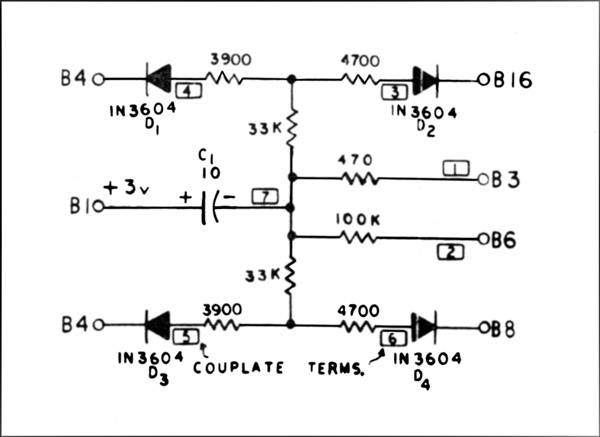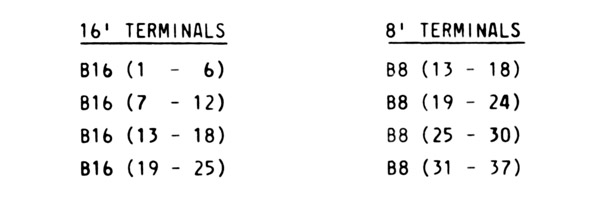The HAMMOND ORGAN
North Suburban HAMMOND ORGAN Society
~ X66 Pedals ~
The pedal section of the X66 behaves in a very similar manner to sections of standard electronic organs that have a feature called percussion sustain. With percussion sustain, a note will sound at a steady volume as long as you hold a key down. When you let go of the key, the note gradually fades out. If you play very staccato with this feature in use, the effect sounds a lot like various types of bells or other instruments that "ring" as opposed to those whose tone stops much more quickly.
In a real pipe organ, the large pipes that produce bass tones will sustain their tone slightly when you let go of a pedal, so that they do not stop sounding instantly, but rather their sound decays gradually, usually in well under a second except for the very largest pipes. Even then, the tone usually drops in volume quickly, and then may sustain for a little longer but at a much quieter level.
Bass tones that sound or ring for a long time after you have let up on the appropriate pedal are generally not good; they make the resulting music sound muddy. However, bass tones that stop instantly when you let up on a pedal don't sound good either, and furthermore, the effect is completely unnatural. The ideal situation for bass tones is for them to begin quite quickly, and then when you release a pedal, for them to fade out quickly, but not instantly. The pedal keying system in the X66 is entirely electronic and it provides four different amounts of decay or sustain for the bass tones. There are two tabs which control this feature, labeled as String Bass I, and String Bass II. The third setting, String Bass III results from turning both of these tabs on, and there is, with both tabs off, still a very slight decay or roll-off to the pedal tones of about 0.25 second even with no SB tabs on. With the SB I tab on, the decay time is 0.5 second, with SB tab II on, it is around 1 second, and with both SB I and SB II on, it is 2 seconds. When you first step on a bass pedal, likewise the tone takes a few milliseconds to reach steady-state volume, and both this slightly gradual attack and the slight rolloff, even with no SB tabs in use, makes a really nice and very natural sounding bass effect. In my opinion, this bass is infinitely better than the instant-on, instant-off bass that you get from a standard Hammond. Evidently, I am not alone in this opinion, as over the years, several companies have made string bass accessories to be added to traditional Hammonds to add this feature, and most other electronic organs that competed with Hammond also included it.
Of course we have to realize [again my opinion] that originally, Hammond wanted his instruments to be replacements for traditional church pipe organs, and in a large and reverberant room, the room acoustics would not only soften the onset of the pedal tone, but also, via reverberation, sustain it after pedal release. But traditional Hammonds could easily be installed in private homes and even small apartments, and in those conditions, the instant-on, instant-off characteristic did not sound good at all.
The term Telegraph Key Sound has been used by many critics of the traditional Hammond, and once again, in my opinion, the term is both accurate and well deserved. Because of the X66's electronic pedal keying, the result is a really good sounding bass that is very musically useful. Below is a look at a typical pedal keying circuit from an X66. The section below the picture is a copy of Hammond's own description of its operation from the X66 Service Manual.
Figure 32. Typical pedal keyer diagram. See text below. Twelve dual keyers are located on the -2 board, and 13 dual keyers on the -3 board. Keyer outputs are collected in note groups as follows:

For example, when low C pedal is played, the 8' signal (freq. #13) and the
16' signal (freq. #1) are conducted through their dual keyer.
When a pedal is pressed, +3 vdc is applied to the corresponding
terminal B3. Capacitor C1 promptly charges up to + 3v through
the 470 ohm resistor. This charging resistance limits the current
through the key contact, and prevents thump in the sound output.
The applied + 3v causes conduction of diodes D1 D2, D3 and D4,
permitting them to pass signal from input to output.
When the pedal is released, + 3v is removed; C1 discharges through
the 100k ohm resistor, gradually removing positive voltage from the diode anodes.
The rate of capacitor discharge depends not only upon the resistance value of
100k ohms but upon the voltage connected to terminal B6. With pedal released,
signal output at terminals B16 and B8 must fall below .0007 v p-p.
The pedal keyer turn-off time after key release varies with string bass tab positions as follows:

From these diagrams and charts, we can see that at all times, the pedal tone envelope is mainly determined by what is happening with capacitor C1. C1 charges through the 470Ω resistor which adds a slight time delay to the buildup of the pedal tone. Likewise, even when there are no string bass tabs in use, the pedal tone rolloff is determined by the time for C1 to discharge through the 100K resistor.
Once again, a personal opinion here. Keying audio signals directly through key contacts is very simple to do. However, keying audio electronically gives a much better musical result, because electronic keying adds the all important attack and decay characteristics to the resulting sound envelope. Envelope in this context means the way a tone starts and ends, as well as its steady-state condition. As we look at the X66 Hammond, we begin to see that it incorporates all of the uniquely nice features of a standard Hammond, and yet also provides the means to eliminate or at least circumvent many of the traditional instrument's shortcomings.
The pedal keyers control the sawtooth wave signals from the frequency dividers. After keying, these sawtooth waves must be appropriately formanted and filtered to produce useful pedal tones. On the next page is a diagram which shows this in some detail.
Previous Page Page 22. Next page coming soon!